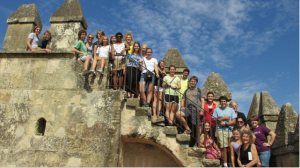
photo: Kara Lofton
Last Sunday (Sept. 8) we visited a region between the Sierra Nevadas and the Mediterranean called Las Alpujarras. Although quite small, these villages are famous for the terraced farmlands that surround them, a unique mini-ecology due to melting snow from higher up the mountains, great for producing bottled water that is sold throughout the rest of Spain.
Specifically we visited a famous trio of villages in the Poqueria Valley, which retain traditional Berber architecture from the time the Muslims ruled Spain. The villages are clustered quite close together and were easy to visit during a single trip.
The mountain roads were narrow and if one happened to be sitting by the window nearest the cliff, it was quite easy to look out the window and straight down into the steep drop to the valley below. I couldn’t help but think how unlikely it was that the guard rails (which came up to maybe wheel height on the bus) would stop us from tumbling over the side of the cliff if we were to get in an accident.
We only stopped briefly at Pampaniera, but it is an interesting place because the iron content in the water is so high that a “hotel hospital” has sprung up. The hotel hospital advertises itself as a place of natural healing for women who are anemic–all they have to do is come for a few days and drink the water. Of course massages and other spa treatments are available should the women get bored drinking water.
Both Bubion and Capileira are well known for their Berber-style architecture and good quality hiking and biking trails. For a while the villages were struggling because young people were leaving to go to the cities or other countries for better work and travel opportunities, but now foreigners have discovered the beauty of Las Alpujarras and as more expats settle in the villages and bring money and business, tourism has boomed.
In Capileira we sat down all together in a little restaurant for a wonderful meal of bread, homemade gazpacho, eggs, potatoes in lots (lots) of olive oil and some of the best cheese I have ever tasted. The meat eaters also had ham, which I heard was very tasty as well. It’s probably fortunate that we went on a short hike afterwards because I think everyone over ate and needed to either move or take a nap in order to recover.
In the middle of the week, we spent a day at Alhambra, a World UNESCO Heritage site. It started as a fortress in the 1st Century, but it grew into a massive palace complex used first by Spain’s Muslim rulers and then by its Christian ones. It’s a must-visit for anyone in this part of Spain.
This Sunday afternoon (Sept. 15) nine of us went to a soccer game–Granada vs. Espanyol, which was really fun, but very, very hot. In the evening, we all gathered at the Snell-Feikema’s for worship.
-Kara Lofton